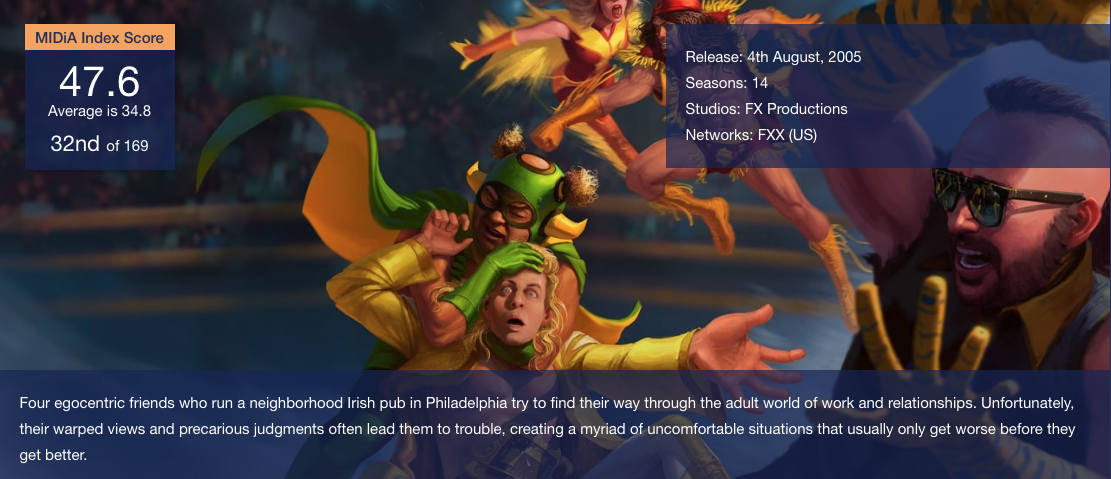Apple TV+ bets on fandom


As the D2C streaming wars coalesce, it is worth zeroing in on some of the propositions in play by the various tech majors, which in turn highlight their respective strategies and may provide some insights into the direction content production will go in an already-saturated attention economy.
Mythic Quest: Raven’s Banquet is a great place to start. An Apple TV+ original production about a video game developer team, it is written by the same creators as It’s Always Sunny in Philadelphia – a long-running, 14-season classic by FX. It’s Always Sunny has, according to MIDiA’s Index platform, a 150% fandom/viewership ratio and 57% awareness among overall consumers. In the last quarter its viewing has gone down by one percentage point, but its fandom penetration has gone up by the same. Intriguingly, the new official cover image for It’s Always Sunny has been replaced with a video-game style superhero parody, perhaps alluding to the new series.

More than merely being written by the same creators, Mythic Quest riffs on the same character dynamics and comedic style, and brings in many of the same actors as It’s Always Sunny; any viewer attracted by “more of something I already like, but new” will be getting exactly what they asked for. Additionally, however, the new show also plays to a very Silicon Valley feel in terms of plot, and the humour there is not too dissimilar either. Silicon Valley has a 56% awareness penetration, and a 156% fandom to viewership ratio – making it, too, a heavyweight cultural hit. Silicon Valley viewers could easily be swept into the fandom fold of the new Mythic Quest, lending heft to the new proposition.
Finally, as with The Witcher – the recent hit Netflix series which played heavily to fans of the video game, likely watched by every player who considered themselves invested in the franchise – Mythic Quest holds gamer appeal. It focuses around a team developing a wildly-popular online multiplayer role-playing game with monetisation assets, not dissimilar to Runescape (a classic for any digital native who so much as dabbled in gaming 10-15 years ago) and closely parodying World of Warcraft, a popular game by Blizzard Entertainment. The YouTube channel for World of Warcraft has 1.42 million subscribers, and the official Twitter account has 1.5 million followers – meaning the voluntarily opted-in audience for associated content is huge.
Featured Report
India market focus A fandom and AI-forward online population
Online Indian consumers are expected to be early movers. They are high entertainment consumers, AI enthusiasts, and high spenders – especially on fandom. This report explores a population that is an early adopter, format-agnostic, mobile-first audience, with huge growth potential.
Find out more…In the world of video streaming, discovery remains a major challenge – no matter how much new content on a platform, old reruns like Friends and The Office (US) tend to be the heaviest hitters in terms of viewing hours and fandom. Whether this is because consumers merely want to watch what they already like or prefer familiar sounds in the background while they are doing something else, this nevertheless raises an interesting propositional distinction for Apple.
Instead of curating massive amounts of content and struggling to generate discovery amongst subscribers, it has selectively chosen a few key series which play to what consumers already like and are interested in — something ‘new but similar’ to, as with Mythic Quest and also even The Morning Show. Indeed, a similar fandom linkage play here was made just before the release of The Morning Show on the 1st of November last year, in that headline actress Jennifer Aniston created an Instagram account two weeks beforehand, launched with a selfie of the Friends cast – setting a Guinness World Record to reach one million followers in five hours and 16 minutes (per TIME).
As Mythic Quest has only been recently released, it remains to be seen what its cultural impact will be. However, its performance will tell us a few key things about the creation of content in a saturated digital environment: developing new things that consumers already are fans of, but in slightly different ways and with high-quality production, may turn out to be a highly-successful way to generate new fandom and engagement. Additionally, as we move progressively into a creator-based economy, it makes sense that these new series are being branded under their creators’ names rather than just the Apple brand – as with the Always Sunny writers and Aniston herself.
However, the Apple exclusivity branding may prove an impediment to uptake; cut-through of messaging may prove difficult, or competitor services may appear more promising. Nevertheless, Apple has a significant fandom bank to play with – whether it spends it wisely is the $6 billion-dollar question.

The discussion around this post has not yet got started, be the first to add an opinion.